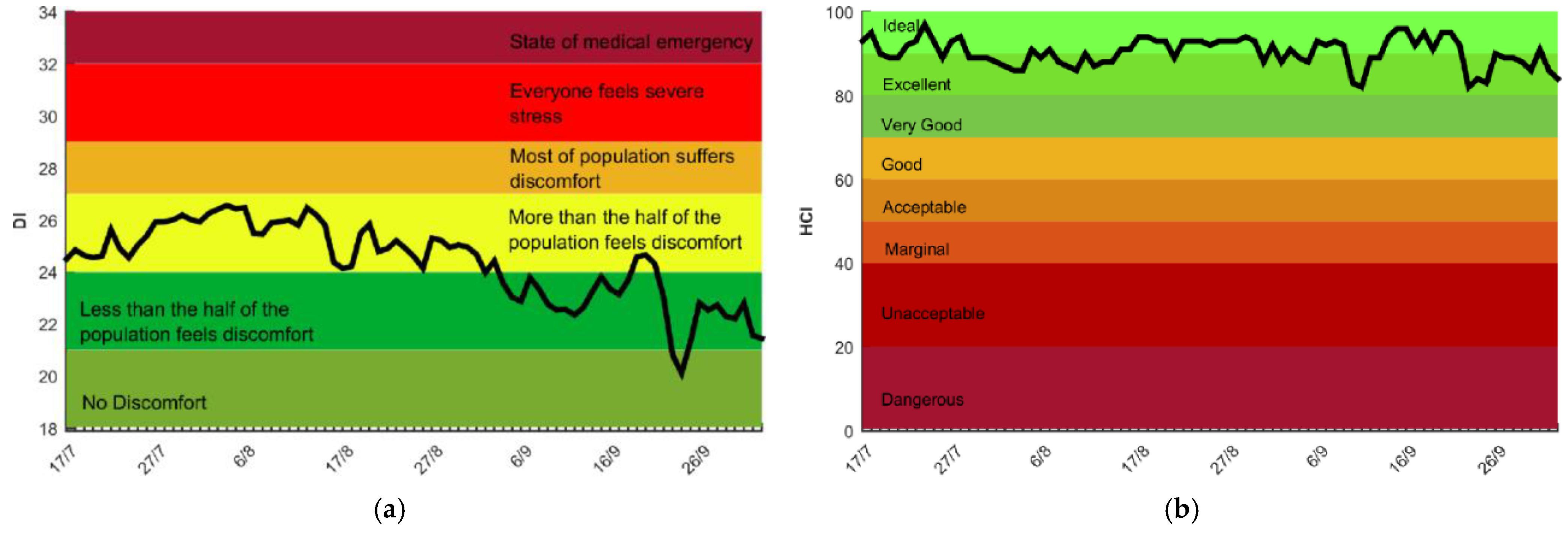Air Quality and Climate Comfort INDICES over the Eastern Mediterranean: The Case of Rhodes City during the Summer of 2021 †
Abstract
:1. Introduction
2. Data and Methods
3. Results
4. Conclusions
Author Contributions
Funding
Institutional Review Board Statement
Informed Consent Statement
Data Availability Statement
Acknowledgments
Conflicts of Interest
References
- World Travel & Tourism Council [WTTC]. Travel & Tourism Economic Impact 2018 Europe. Available online: https://wttc.org/Research/Economic-Impact (accessed on 24 February 2020).
- Demiroglu, O.; Saygili-Araci, F.; Pacal, A.; Hall, C.; Kurnaz, M. Future Holiday Climate Index (HCI) Performance of Urban and Beach Destinations in the Mediterranean. Atmosphere 2020, 11, 911. [Google Scholar] [CrossRef]
- International Tourism Consolidates Strong Recovery Amidst Growing Challenges. Available online: https://www.unwto.org/taxonomy/term/347 (accessed on 18 February 2022).
- Medieval City of Rhodes. Available online: https://whc.unesco.org/en/list/493/ (accessed on 25 February 2022).
- Logothetis, I.; Antonopoulou, C.; Sfetsioris, K.; Mitsotakis, A.; Grammelis, P. Comparison Analysis of the Effect of High and Low Port Activity Seasons on Air Quality in the Port of Heraklion. Environ. Sci. Proc. 2021, 8, 3. [Google Scholar] [CrossRef]
- Shukla, J.; Misra, A.; Sundar, S.; Naresh, R. Effect of rain on removal of a gaseous pollutant and two different particulate matters from the atmosphere of a city. Math. Comput. Model. 2008, 48, 832–844. [Google Scholar] [CrossRef]
- Amelung, B.; Viner, D. Mediterranean Tourism: Exploring the Future with the Tourism Climatic Index. J. Sustain. Tour. 2006, 14, 349–366. [Google Scholar] [CrossRef]
- Sillmann, J.; Aunan, K.; Emberson, L.; Bueker, P.; Van Oort, B.; O’Neill, C.; Otero, N.; Pandey, D.; Brisebois, A. Combined impacts of climate and air pollution on human health and agricultural productivity. Environ. Res. Lett. 2021, 16, 093004. [Google Scholar] [CrossRef]
- Logothetis, I.; Antonopoulou, C.; Zisopoulos, G.; Mitsotakis, A.; Grammelis, P. The Impact of Climate Conditions and Traffic Emissions on the Pms Variations in Rhodes City during the Summer of 2021. In Proceedings of the 7th World Congress on Civil, Structural, and Environmental Engineering, Virtual, 10–12 April 2022. [Google Scholar] [CrossRef]
- Su, T.; Li, Z.; Kahn, R. Relationships between the planetary boundary layer height and surface pollutants derived from lidar observations over China: Regional pattern and influencing factors. Atmospheric Chem. Phys. 2018, 18, 15921–15935. [Google Scholar] [CrossRef]
- Majdi, M.; Turquety, S.; Sartelet, K.; Legorgeu, C.; Menut, L.; Kim, Y. Impact of wildfires on particulate matter in the Euro-Mediterranean in 2007: Sensitivity to some parameterizations of emissions in air quality models. Atmospheric Chem. Phys. 2019, 19, 785–812. [Google Scholar] [CrossRef]
- Poupkou, A.; Nastos, P.; Melas, D.; Zerefos, C. Climatology of Discomfort Index and Air Quality Index in a Large Urban Mediterranean Agglomeration. Water Air Soil Pollut. 2011, 222, 163–183. [Google Scholar] [CrossRef]
- Nastos, T.P. Weather, ambient air pollution and bronchial asthma in Athens, Greece. In Seasonal Forecasts, Climatic Change and Human Health; Thomson, M.C., Ed.; Springer Science: New York, NY, USA, 2008; pp. 173–188. [Google Scholar]
- Government of Canada. Heat and Humidity. Available online: https://www.canada.ca/en/environmentclimate-change/services/seasonal-weather-hazards/warm-season-weather-hazards.html#toc7 (accessed on 25 February 2022).
- Hasanah, N.A.I.; Maryetnowati, D.; Edelweis, F.N.; Indriyani, F.; Nugrahayu, Q. The climate comfort assessment for tourism purposes in Borobudur Temple Indonesia. Heliyon 2020, 6, e05828. [Google Scholar] [CrossRef] [PubMed]
- Stephenson, D.B. Use of the “odds ratio” for diagnosing forecast skill. Weather. Forecast. 2000, 15, 221–232. [Google Scholar] [CrossRef]
- Wilks, D.S. Forecast Verification. Statistical Methods in the Atmospheric Sciences; Academic Press: New York, NY, USA, 1995. [Google Scholar]




Publisher’s Note: MDPI stays neutral with regard to jurisdictional claims in published maps and institutional affiliations. |
© 2022 by the authors. Licensee MDPI, Basel, Switzerland. This article is an open access article distributed under the terms and conditions of the Creative Commons Attribution (CC BY) license (https://creativecommons.org/licenses/by/4.0/).
Share and Cite
Logothetis, I.; Antonopoulou, C.; Zisopoulos, G.; Mitsotakis, A.; Grammelis, P. Air Quality and Climate Comfort INDICES over the Eastern Mediterranean: The Case of Rhodes City during the Summer of 2021. Environ. Sci. Proc. 2022, 19, 1. https://doi.org/10.3390/ecas2022-12833
Logothetis I, Antonopoulou C, Zisopoulos G, Mitsotakis A, Grammelis P. Air Quality and Climate Comfort INDICES over the Eastern Mediterranean: The Case of Rhodes City during the Summer of 2021. Environmental Sciences Proceedings. 2022; 19(1):1. https://doi.org/10.3390/ecas2022-12833
Chicago/Turabian StyleLogothetis, Ioannis, Christina Antonopoulou, Georgios Zisopoulos, Adamantios Mitsotakis, and Panagiotis Grammelis. 2022. "Air Quality and Climate Comfort INDICES over the Eastern Mediterranean: The Case of Rhodes City during the Summer of 2021" Environmental Sciences Proceedings 19, no. 1: 1. https://doi.org/10.3390/ecas2022-12833
APA StyleLogothetis, I., Antonopoulou, C., Zisopoulos, G., Mitsotakis, A., & Grammelis, P. (2022). Air Quality and Climate Comfort INDICES over the Eastern Mediterranean: The Case of Rhodes City during the Summer of 2021. Environmental Sciences Proceedings, 19(1), 1. https://doi.org/10.3390/ecas2022-12833







